2022 UBS-AM Default study
UBS Asset Management | A story of opposites
Introduction
Introduction
This paper examines our default outlook for 2022, expectations for rising stars and fallen angels and concludes with our total return forecasts for the year.
Key takeaways:
Expected default rate | Expected default rate | UBS-AM 2022 | UBS-AM 2022 |
|---|---|---|---|
Expected default rate | Asia ex-Japan High Yield | UBS-AM 2022 | Approx. 15% |
Expected default rate | EMD Corporates | UBS-AM 2022 | Approx. 3% |
Expected default rate | US High Yield | UBS-AM 2022 | <2% |
Expected default rate | EUR High Yield | UBS-AM 2022 | <1% |
- An increase in the number of “Rising stars”, i.e., issuers upgraded from High Yield to Investment Grade, will be a key trend in 2022
- Asian High Yield tops our return expectations for major asset classes this year with an estimated gain of up to 15%, following a disappointing 2021.
- For developed market HY and Emerging Markets Corporates, our total return projections are in the range of 1-2.5%.
UBS-AM Default study
UBS-AM Default study
The UBS-AM default study is based on a proprietary, bond by bond analysis conducted by our dedicated team of credit analysts. The team utilizes reference indices to form a comprehensive, bottom-up estimate of defaults and distressed exchanges by industry.
- We forecast defaults in developed markets to hit all- time lows:
- EUR HY below 1%
- US HY under 2%
- In Asia ex Japan, we expect an approx. 15% default rate
- For the first time, our study captures EMD corporates where we estimate a modest 3% default rate this year
Asia ex-Japan High Yield defaults expected to be approx. 15% (USD mn)
Asia ex-Japan High Yield defaults expected to be approx. 15% (USD mn)
Within Asia ex-Japan HY, the real estate sector is an outlier at a 28% expected default rate, mostly emanating from China. Our view is credit losses from potential defaults within the sector are already largely reflected in current pricing. On average we expect recoveries of between 30-40pct of face value with any large variance from our range likely driven by asset quality and government intervention.
After China, Sri Lanka stands out due to persistent weakness in the country’s tourism sector, lack of a fiscal consolidation strategy and a heavy debt repayment schedule in 2022.
By sector
By sector
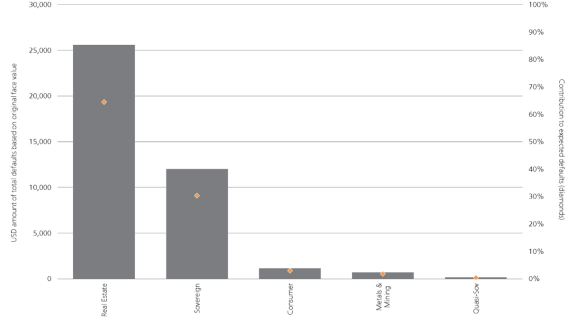
By Country
By Country

Emerging Market Corporate defaults expected to be approx. 3% (USD mn)
Emerging Market Corporate defaults expected to be approx. 3% (USD mn)
Within EMD corporates, we expect Financials to potentially be the largest contributor to total defaults, due in part to the possibility of stress on the Turkish banking system that could impact some of the smaller and weaker Tier-2 banks. Default projections in TMT are also above average driven by concerns over a particular single issuer. Additionally, Real Estate stands out due to pressures in the Chinese property sector.
By geography, Europe’s expected default rate may be driven by the aforementioned stress in Türkiye where the Lira depreciated more than 80% in 2021 amid turmoil at the central bank and the pursuit of unorthodox monetary policy. Aside from the weaker tier-2 banks, Turkish corporates that generate predominately all their revenues from domestic sources but are exposed to liabilities in foreign currency are likely to exhibit some level of vulnerability in 2022. We do acknowledge that some of these risks in Turkish corporates are mitigated by their strong credit profiles, continued access to wholesale capital markets, and experience operating in severely stressed market conditions.
By sector
By sector
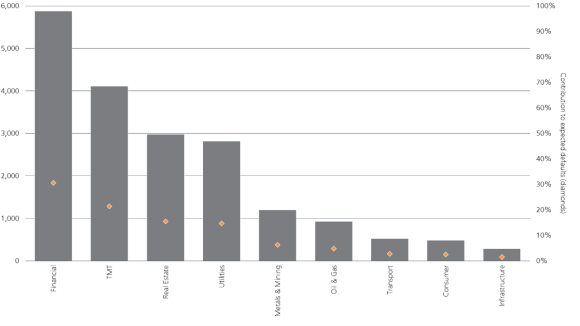
By Geography
By Geography
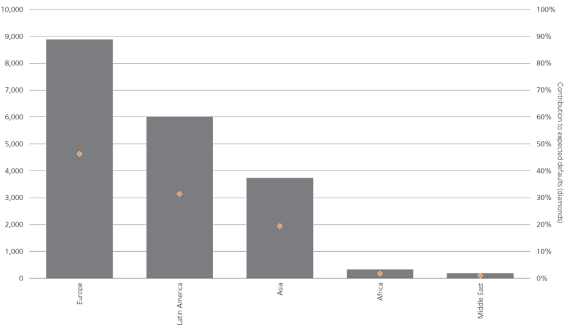
US High Yield defaults expected to be under 2% (USD mn)
US High Yield defaults expected to be under 2% (USD mn)
Main contributors are the Media and Utility sectors, predominantly because of advertising/publishing companies, as well as a single utility issuer expected to undergo a debt exchange in the context of a relatively small sector.
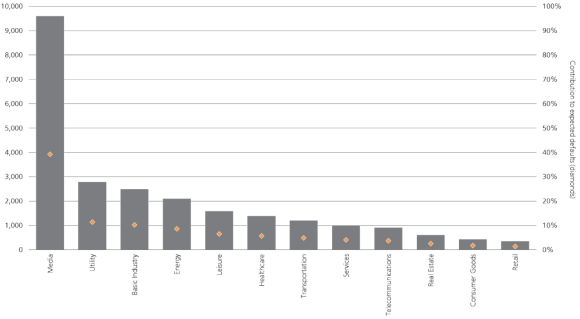
EUR High Yield defaults expected to be below 1% (EUR mn)
EUR High Yield defaults expected to be below 1% (EUR mn)
Our forecast for EUR HY default rates to reach historical lows is informed by our view that the fundamental backdrop will remain solid and that issuers will benefit from a combination of ample liquidity and improving credit metrics.
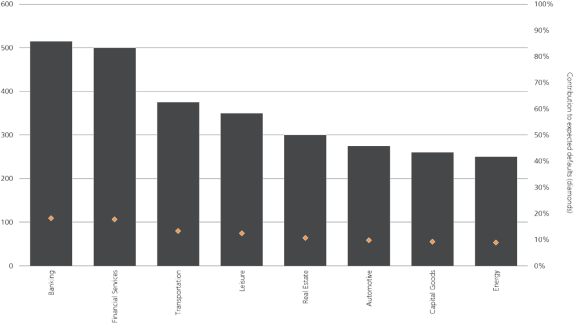
Rising Stars & Fallen Angels
Rising Stars & Fallen Angels
In Developed markets, we expect a reversal of the uptick in fallen angels that occurred in 2020, especially in sectors such as Autos, Energy and TMT, triggered by the COVID-19 pandemic. Although rising stars were noticeably absent that year, there was a modicum of hope in 2021 as evidenced by the charts on the right. We believe this is an important inflection point that sets us up for a strong upgrade cycle and a favorable rising star to fallen angel ratio in 2022. In general, we are optimistic because these issuers stand to benefit from:
- Better cost controls
- Balance sheet improvement
- Strong consumer spending
- Low capital needs
- Recovery in commodity prices
Despite our constructive outlook, certain sectors may experience a deterioration in the ratio of rising stars to fallen angels. Notable among these are:
- Investment grade rated European Supermarkets as competition intensifies and margin compression is exacerbated by high inflation.
- In Europe, within utilities, we expect certain solid A- rated issuers to migrate to mid -BBB ratings as they pursue shareholder friendly activity at the expense of maintaining their pristine ratings.
European Rising Stars (volume per annum)
European Rising Stars (volume per annum)
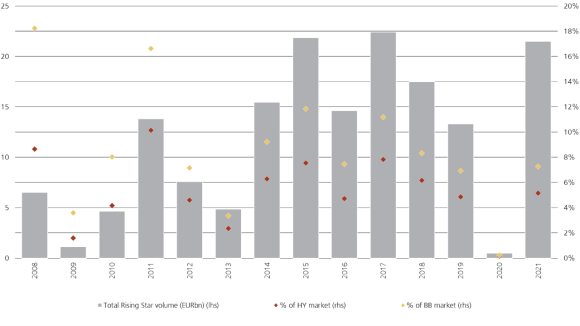
US Rising Stars (volume per annum)
US Rising Stars (volume per annum)
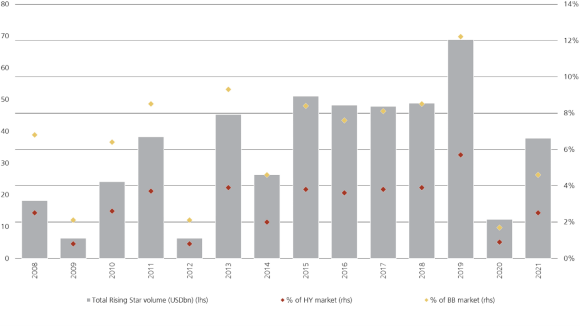
In Emerging Markets, we expect a general trend of rising stars due to strength in the broader commodities complex across all regions.
We see fallen angel risk in certain countries in Latam where quasi-sovereigns and financial institutions have rating profiles directly or indirectly linked to the sovereign rating.
In Asia, continued stress across the Chinese Property sector could lead to an increase in the number of fallen angels; however, we think that state-owned investment grade property developers are going to maintain their credit ratings given expectations of state support.
Total return forecasts
Total return forecasts
The Fixed Income Investment Forum remains broadly constructive on high yield and emerging markets overall, and we forecast expected total returns to be positive for these sectors for 2022. Our base case is for Asia HY to generate returns of up to 15%, followed by EM Corporates with just under 2.5% return and the trio of, Short Duration HY, EUR HY and US HY all estimated to gain between 1-2% for the year.
Make an inquiry
Fill in an inquiry form and leave your details – we’ll be back in touch.
Introducing our leadership team
Meet the members of the team responsible for UBS Asset Management’s strategic direction.
